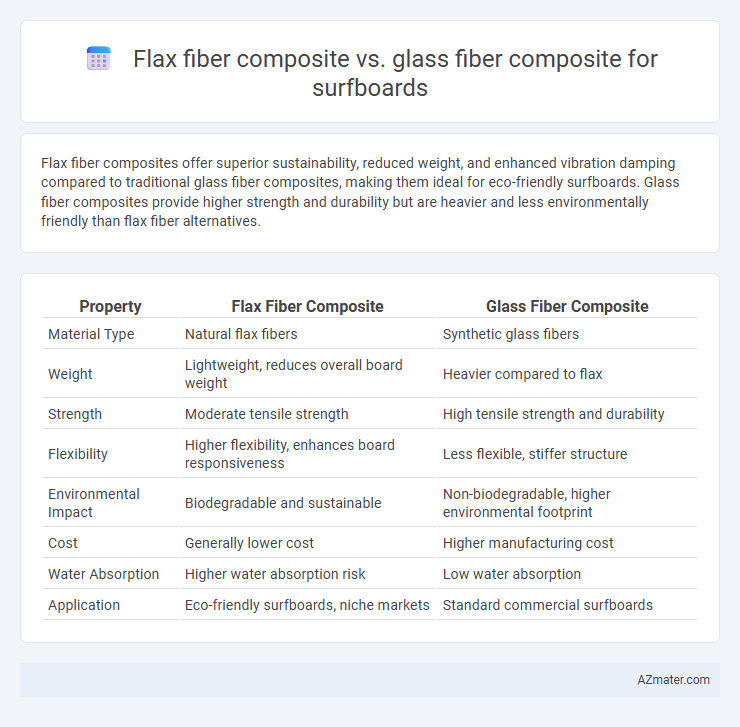Flax fiber composites offer superior sustainability, reduced weight, and enhanced vibration damping compared to traditional glass fiber composites, making them ideal for eco-friendly surfboards. Glass fiber composites provide higher strength and durability but are heavier and less environmentally friendly than flax fiber alternatives.
Table of Comparison
| Property | Flax Fiber Composite | Glass Fiber Composite |
|---|---|---|
| Material Type | Natural flax fibers | Synthetic glass fibers |
| Weight | Lightweight, reduces overall board weight | Heavier compared to flax |
| Strength | Moderate tensile strength | High tensile strength and durability |
| Flexibility | Higher flexibility, enhances board responsiveness | Less flexible, stiffer structure |
| Environmental Impact | Biodegradable and sustainable | Non-biodegradable, higher environmental footprint |
| Cost | Generally lower cost | Higher manufacturing cost |
| Water Absorption | Higher water absorption risk | Low water absorption |
| Application | Eco-friendly surfboards, niche markets | Standard commercial surfboards |
Introduction to Surfboard Composite Materials
Flax fiber composites offer a sustainable alternative to traditional glass fiber composites in surfboard manufacturing, providing comparable strength with reduced environmental impact. Glass fiber composites have long been favored for their high durability, stiffness, and cost-effectiveness, but flax fibers deliver better vibration damping and lower weight. Innovations in resin systems and fiber treatments enhance the mechanical properties of flax composites, making them increasingly viable for high-performance surfboards.
Overview of Flax Fiber Composites
Flax fiber composites offer a sustainable alternative to glass fiber composites in surfboard manufacturing due to their lower environmental impact and comparable mechanical properties such as tensile strength and flexibility. These natural fiber composites provide enhanced vibration damping and biodegradability, making them ideal for eco-conscious surfers. The lighter weight and improved energy absorption of flax fiber composites contribute to better board performance and rider comfort.
Overview of Glass Fiber Composites
Glass fiber composites consist of glass fibers embedded in a polymer matrix, offering high tensile strength and durability crucial for surfboard performance. Their resistance to moisture and UV degradation ensures long-lasting structural integrity, making them a popular choice in surfboard manufacturing. The lightweight nature of glass fiber composites also contributes to enhanced maneuverability and speed on the water.
Mechanical Properties Comparison
Flax fiber composites exhibit lower density and higher specific strength compared to glass fiber composites, making them suitable for lightweight surfboard applications. Although glass fiber composites possess superior tensile strength and stiffness, flax fibers provide better impact resistance and flexural properties, enhancing board durability. The biodegradability and vibration-damping capacity of flax fiber composites contribute to improved environmental sustainability and rider comfort in surfboard manufacturing.
Weight and Performance Differences
Flax fiber composites offer significantly lower weight compared to glass fiber composites, enhancing surfboard buoyancy and maneuverability for surfers. The natural flax fibers provide comparable strength and flexibility, resulting in improved responsiveness and a smoother ride under various wave conditions. Glass fiber composites remain heavier and stiffer, which can increase durability but reduce overall performance in terms of agility and speed on the water.
Environmental Impact and Sustainability
Flax fiber composites offer a significant environmental advantage over glass fiber composites by being derived from renewable plant sources and exhibiting higher biodegradability, reducing long-term waste in surfboard production. The cultivation of flax requires less energy and generates fewer carbon emissions compared to the energy-intensive manufacturing process of glass fibers, which rely on non-renewable raw materials like silica sand. Using flax fiber composites in surfboards not only lowers the ecological footprint but also promotes sustainability through enhanced recyclability and reduced reliance on fossil fuels.
Cost Analysis: Flax vs Glass Fiber
Flax fiber composites offer a cost advantage over glass fiber composites in surfboard manufacturing due to lower raw material prices and reduced environmental processing expenses. While glass fiber composites typically have higher initial costs driven by resin and manufacturing energy consumption, flax fibers provide a sustainable alternative with comparable performance at a lower price point. Cost analysis reveals flax fiber surfboards can reduce overall manufacturing expenses by up to 20%, making them an economically viable option for eco-conscious producers.
Durability and Longevity in Surf Conditions
Flax fiber composites offer superior resistance to saltwater corrosion compared to glass fiber composites, enhancing durability in marine environments. The natural flexibility of flax fibers reduces the likelihood of cracking under repeated flexing and impact during surfing sessions. Glass fiber composites tend to exhibit higher stiffness but are prone to delamination and gradual weakening from UV exposure and saltwater, limiting their longevity on surfboards.
User Experience and Ride Quality
Flax fiber composites offer enhanced vibration damping and a smoother ride quality compared to glass fiber composites, making them highly favored for surfboards focused on comfort and control. The natural flex properties of flax fibers provide better responsiveness and a more connected feel with the wave, improving user experience for both beginners and advanced riders. In contrast, glass fiber composites tend to be stiffer and heavier, which may result in a less forgiving ride and reduced tactile feedback on the water.
Future Trends in Surfboard Composite Materials
Flax fiber composites offer a sustainable alternative to traditional glass fiber composites in surfboard manufacturing, providing similar strength-to-weight ratios while significantly reducing environmental impact. Advances in bio-resin technology and hybrid flax-glass fiber combinations are driving innovation, enhancing durability and performance without compromising eco-friendliness. Future trends indicate that surfboard composites will increasingly integrate natural fibers like flax with recycled materials, aiming to meet both performance demands and sustainability goals in the watersports industry.

Infographic: Flax fiber composite vs Glass fiber composite for Surfboard
 azmater.com
azmater.com